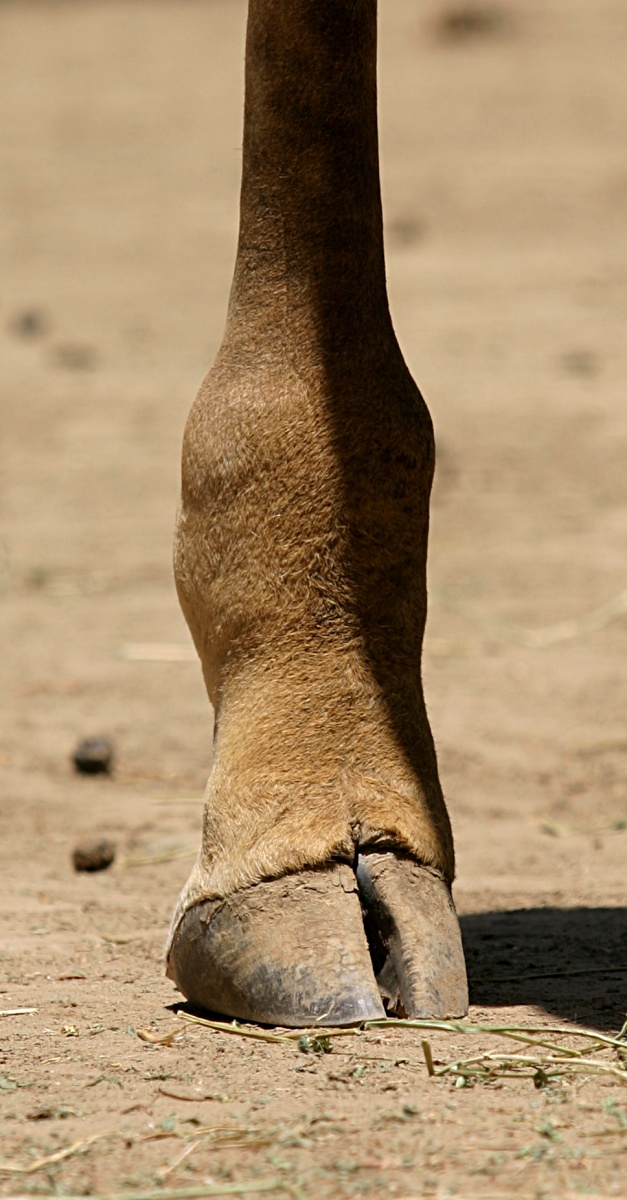- Even-toed ungulate
Taxobox
name = Even-toed ungulates
fossil_range = EarlyEocene - Recent

image_caption = Right-rear foot of aMasai Giraffe ("Giraffa camelopardalis tippelskirchi") at theSan Diego Zoo
regnum =Animal ia
phylum = Chordata
classis =Mammalia
infraclassis =Eutheria
superordo =Laurasiatheria
ordo = Artiodactyla*
ordo_authority = Owen, 1848
subdivision_ranks = Families
subdivision =Antilocapridae Bovidae Camelidae Cervidae Giraffidae Hippopotamidae Moschidae Suidae Tayassuidae Tragulidae Leptochoeridae †Dichobunidae †Cebochoeridae †Entelodontidae †Anoplotheriidae †Anthracotheriidae †Cainotheriidae †Agriochoeridae †Merycoidodontidae †Leptomerycidae †Protoceratidae †Oromerycidae †Xiphodontidae †Amphimerycidae †Helohyidae †Gelocidae †Dromomerycidae †Raoellidae †Choeropotamidae †Sanitheriidae †Climacoceratidae †Palaeomerycidae †The even-toed ungulates form the
mammal order Artiodactyla. They areungulate s whose weight is borne (if they have more than two toes) about equally by the third and fourth toes, rather than mostly or entirely by the third as inperissodactyls . Another key distinguishing feature is the shape of the astragalus (a bone in the hock joint), which has a double-pulley structure in artiodactyls, giving the foot greater flexibility.cite book |author= Savage, RJG, & Long, MR|year=1986 |title= Mammal Evolution: an illustrated guide|publisher= Facts on File|location=New York|pages= 208|isbn= 0-8160-1194-X]There are about 220 artiodactyl
species , including many that are of great nutritional,economic and cultural importance to humans.Evolution
As with many animal groups, even-toed ungulates first appeared during the Early
Eocene (about 54 million years ago). In form they were rather like today'schevrotain s: small, short-legged creatures that ateleaves and the soft parts ofplants . By the Late Eocene (46 million years ago), the three modern suborders had already developed:Suina (thepig group);Tylopoda (thecamel group); andRuminantia (thegoat andcattle group). Nevertheless, artiodactyls were far from dominant at that time: theodd-toed ungulate s (ancestors of today'shorse s and rhinos) were much more successful and far more numerous. Even-toed ungulates survived in niche roles, usually occupying marginal habitats, and it is presumably at that time that they developed their complexdigestive system s, which allowed them to survive on lower-grade food.The appearance of grasses during the
Eocene and their subsequent spread during theMiocene (about 20 million years ago) saw a major change: grasses are very difficult to eat and the even-toed ungulates with their highly-developedstomach s were better able to adapt to this coarse, low-nutrition diet, and soon replaced the odd-toed ungulates as the dominant terrestrialherbivore s. Now-extinct Artiodactyla which developed during theMiocene include the speciesAmpelomeryx ,Tauromeryx ,Triceromeryx , and others.Suina
Suina (
pigs and peccaries) are artiodactyls that retain four toes of fairly equal size, have simpler molars, short legs, and often have enlargedcanine teeth that formtusk s. In general, they areomnivore s and have a simple stomach, except for the twohippopotamus species and thebabirusa which are herbivores.cite book |editor=Macdonald, D.|author= Janis, Christine & Jarman, Peter|year=1984 |title= The Encyclopedia of Mammals|publisher= Facts on File|location=New York|pages= 498-499|isbn= 0-87196-871-1]Hippopotamidae have been considered a member ofSuina , however, recent morphological and genetic research suggests that hippos are more closely related towhales .Cite journal | url = http://mbe.oxfordjournals.org/cgi/content/abstract/14/5/537 | title = More DNA support for a Cetacea/Hippopotamidae clade: the blood-clotting protein gene gamma-fibrinogen | author = Gatesy, J. | journal =Molecular Biology and Evolution | volume = 14 | pages = 537–543 | pmid = 9159931]Camelids and Ruminantia
Camelid s andRuminantia tend to be longer-legged, to walk on only the central two toes (though the outer two may survive as rarely-used dew-claws) and to have more complex cheek teeth well-suited to grinding up tough grasses. They have evolved a highly developed digestive process in which partly-digested food is regurgitated and re-chewed ("chewing thecud " or "cudding"). This complex digestion takes place in a multi-chambered stomach, therumen itself. It allows them to usefermentation bymicroorganisms to digestcellulose , a plant material which animals cannot digest directly.Cetaceans
One group of artiodactyls (which
molecular biology suggests were most closely related to Hippopotamidae) returned to the sea to become whales. Thus Artiodactyla withoutCetacea is a paraphyletic group. For this reason, the termCetartiodactyla was coined to refer to the group containing both artiodactyls and whales.cite journal |last=Boisserie |first=Jean-Renaud |coauthors= Fabrice Lihoreau and Michel Brunet |year= 2005 |month= February |title= The position of Hippopotamidae within Cetartiodactyla |journal=Proceedings of the National Academy of Sciences |volume= 102 |issue= 5 |pages= 1537–1541|url= http://www.pnas.org/cgi/content/full/102/5/1537|accessdate= 2007-06-09 |doi= 10.1073/pnas.0409518102 |pmid= 15677331]Classification
*
Cetartiodactyla (unrankedclade , higher than Artiodactyla)
** FamilyHippopotamidae : hippos
** OrderCetaceans : whales, dolphins and porpoises
** ORDER ARTIODACTYLA
*** SuborderSuina
**** FamilySuidae : pigs
**** FamilyTayassuidae : peccaries
*** SuborderTylopoda
**** FamilyCamelidae : camels andllama s
*** SuborderRuminantia
**** InfraorderPecora
***** FamilyAntilocapridae :pronghorn
***** FamilyBovidae : cattle, goats,sheep , andantelope
***** FamilyCervidae :deer
***** FamilyGiraffidae :Giraffe andOkapi
***** FamilyMoschidae : musk deer
**** InfraorderTragulina
***** FamilyTragulidae : chevrotainsSee also
*
Odd-toed ungulate References
Wikimedia Foundation. 2010.
